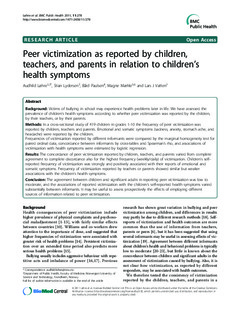| dc.contributor.author | Løhre, Audhild | |
| dc.contributor.author | Lydersen, Stian | |
| dc.contributor.author | Paulsen, Bård | |
| dc.contributor.author | Mæhle, Magne Olav | |
| dc.contributor.author | Vatten, Lars Johan | |
| dc.date.accessioned | 2015-09-11T12:27:21Z | |
| dc.date.accessioned | 2015-09-30T12:18:42Z | |
| dc.date.available | 2015-09-11T12:27:21Z | |
| dc.date.available | 2015-09-30T12:18:42Z | |
| dc.date.issued | 2011 | |
| dc.identifier.citation | BMC Public Health 2011, 11 | nb_NO |
| dc.identifier.issn | 1471-2458 | |
| dc.identifier.uri | http://hdl.handle.net/11250/1201379 | |
| dc.description.abstract | Background: Victims of bullying in school may experience health problems later in life. We have assessed the
prevalence of children’s health symptoms according to whether peer victimization was reported by the children,
by their teachers, or by their parents.
Methods: In a cross-sectional study of 419 children in grades 1-10 the frequency of peer victimization was
reported by children, teachers and parents. Emotional and somatic symptoms (sadness, anxiety, stomach ache, and
headache) were reported by the children.
Frequencies of victimization reported by different informants were compared by the marginal homogeneity test for
paired ordinal data, concordance between informants by cross-tables and Spearman’s rho, and associations of
victimization with health symptoms were estimated by logistic regression.
Results: The concordance of peer victimization reported by children, teachers, and parents varied from complete
agreement to complete discordance also for the highest frequency (weekly/daily) of victimization. Children’s selfreported
frequency of victimization was strongly and positively associated with their reports of emotional and
somatic symptoms. Frequency of victimization reported by teachers or parents showed similar but weaker
associations with the children’s health symptoms.
Conclusion: The agreement between children and significant adults in reporting peer victimization was low to
moderate, and the associations of reported victimization with the children’s self-reported health symptoms varied
substantially between informants. It may be useful to assess prospectively the effects of employing different
sources of information related to peer victimization. | nb_NO |
| dc.language.iso | eng | nb_NO |
| dc.publisher | BioMed Central | nb_NO |
| dc.title | Peer victimization as reported by children, teachers, and parents in relation to children's health symptoms | nb_NO |
| dc.type | Journal article | nb_NO |
| dc.type | Peer reviewed | en_GB |
| dc.date.updated | 2015-09-11T12:27:21Z | |
| dc.subject.nsi | VDP::Medisinske fag: 700::Helsefag: 800::Samfunnsmedisin, sosialmedisin: 801 | nb_NO |
| dc.subject.nsi | VDP::Midical sciences: 700::Health sciences: 800::Community medicine, social medicine: 801 | nb_NO |
| dc.subject.nsi | VDP::Samfunnsvitenskap: 200::Psykologi: 260::Sosial- og arbeidspsykologi: 263 | nb_NO |
| dc.subject.nsi | VDP::Social sciences: 200::Psychology: 260::Social and occupational psychology: 263 | nb_NO |
| dc.source.volume | 11 | nb_NO |
| dc.source.journal | BMC Public Health | nb_NO |
| dc.identifier.doi | 10.1186/1471-2458-11-278 | |
| dc.identifier.cristin | 837293 | |
| dc.description.localcode | © 2011 Løhre et al; licensee BioMed Central Ltd. This is an Open Access article distributed under the terms of the Creative Commons Attribution License (http://creativecommons.org/licenses/by/2.0), which permits unrestricted use, distribution, and reproduction in any medium, provided the original work is properly cited. | nb_NO |
